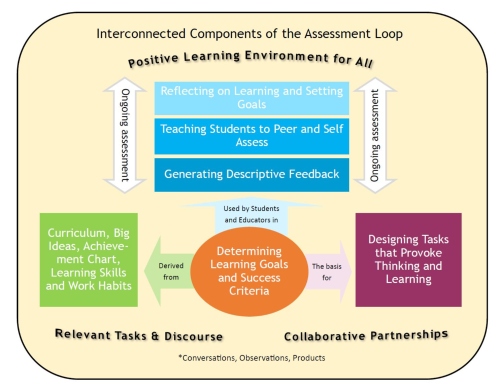“…the only simplicity to be trusted is the simplicity to be found on the far side of complexity.” Alfred North Whitehead
Download Assessment Loop graphic:
‘I want to simplify the process of assessing my students! How do I begin?’
Embrace the complexity to find simplicity.
The goal of both assessment and instruction is for students to become autonomous and independent learners. This responsibility weighs heavily on the shoulders of educators. It seems a daunting task to meet all the instructional needs, then to provide feedback, then know when to reteach or move on, and then to do this, and this, and this… So many pieces of the puzzle and more are added all the time! What if this additive process could be transformed? Harnessing the power of assessment results in a powerful simplification: by involving students in the language and process of assessment, the shared responsibility of learning and goal setting ripples out to each individual student – the entire community moving the learning forward.
Assessment is a cyclical process.
Designing a graphic to represent the intricacies of both assessment and instruction is not easy. At best it is an overview of simplified thinking; at its worse the graphic is confusing. Where do we start?
A process is a series of actions aimed at achieving a goal. In the assessment process, the steps are cyclical – we like to call it the assessment loop. The actions in this cyclical process include:
- Determining the learning goals and success criteria;
- Designing tasks that provoke thinking and learning;
- Generating descriptive feedback;
- Teaching students to peer and self-assess;
- Reflecting on learning and setting goals.
In our graphic, these actions rest on a yellow rectangle symbolizing the co-learning environment. For the assessment loop to be highly effective, there are ongoing conditions that need to be established and present:
- A positive learning environment for all;
- Collaborative partnerships between educators and students; students and peers; home and school;
- Relevant, meaningful tasks that promote discourse and thinking;
- Multiple opportunities for learners to demonstrate their learning in a variety of ways through observations, conversations and products.
Learning goals and success criteria are the core elements.
Learning goals and success criteria:
- Make the learning transparent for students, translating curriculum expectations and big ideas into student-friendly language;
- Form the basis for designing tasks that promote thinking and learning;
- Generate descriptive feedback used by educators and students;
- Support students in the process of self and peer assessment;
- Enable students to reflect on their learning and set personal goals.
The assessment loop is not linear but rather a series of interdependent, interrelated actions. When these are aligned and seamlessly interconnected, teachers empower students to learn.
![]() One last thought — and a call to action:
One last thought — and a call to action:
If you are thinking about transforming your assessment practices, this process may feel overwhelming. Don’t stress – because the assessment loop cycles continuously (that’s why it’s called the assessment loop!), it doesn’t matter where you start – you will explore the other elements.
 If you are interested in learning more about feedback or goal setting, then start your personal inquiry with that in mind — just start! Pick a door, and jump in!
If you are interested in learning more about feedback or goal setting, then start your personal inquiry with that in mind — just start! Pick a door, and jump in!
Visit the blog regularly as we unpack different components of the assessment loop. Remember: embrace the complexity to find simplicity.
Everything should be made as simple as possible, but no simpler. Albert Einstein
References: Retrieved from AZQuotes https://www.azquotes.com/author/15592-Alfred_North_Whitehead?p=10
Einstein, Albert. https://en.wikiquote.org/wiki/Albert_Einstein


11 comments